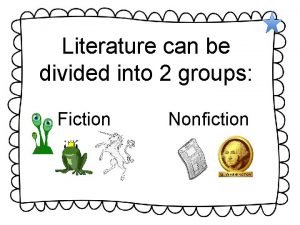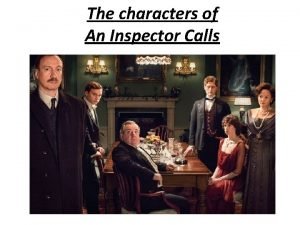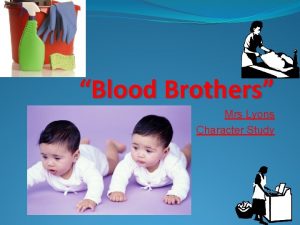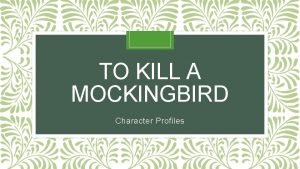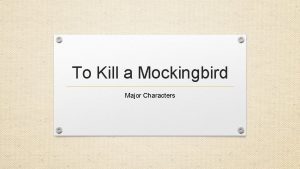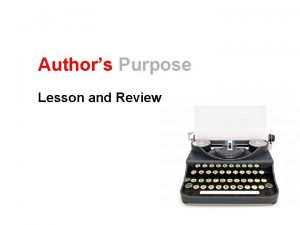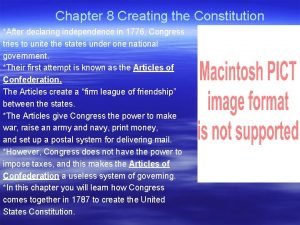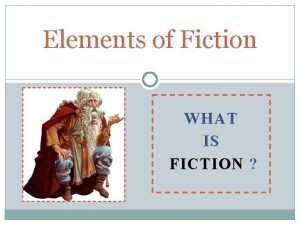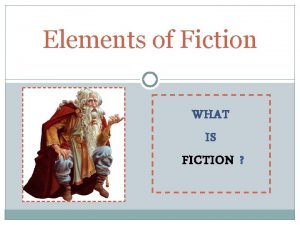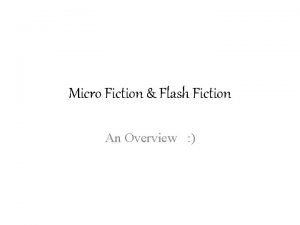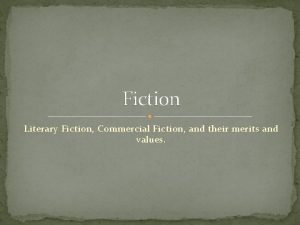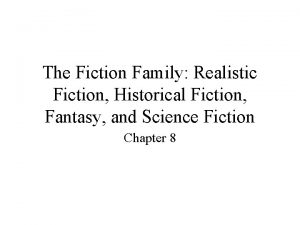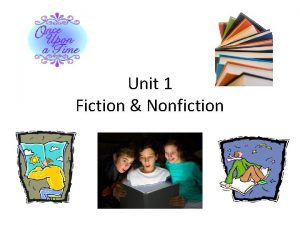Creating a Character Profile Fiction Character Profile When




















- Slides: 20

Creating a Character Profile Fiction

Character Profile �When you get an idea for a short story or a novel, you probably get the basic idea of the characters in it. But in order to build believable characters, you need more than just a basic idea of them. You need to really know them. The easiest way to flesh out a character is with a character profile.

Describing Appearance �In your journal, describe a friend or a relative as though you were writing a wanted poster. �Your description might read like this: �Tom Holman is seventeen years old. He is 5 feet 10 inches and weighs 155 pounds. He has dark brown eyes and thick, curly black hair. There is a small mole under his left eye. � This kind of description might help someone pick Tom Holman out of a lineup, but it doesn’t tell you what Tom is like. It doesn’t tell you whether Tom is friendly or cold, generous or mean, shy or pushy. It doesn’t tell you whether he is self-conscious or casual, funny or dull. These are the emotional traits that a fiction writer wants to reveal. �Enlarge upon your basic description! Use physical details to show what the person is really like. . .

What they look like �Some ancient philosophers taught that a person’s inner self was revealed by his outward appearance. The Latin writer Cicero said, “the face is the image of the soul. ” Whether true or not, for hundreds of years storytellers have acted on this belief. The good guys have looked good, and the bad guys have looked bad. The handsome Beowulf, for instance, in his gleaming armor, fights Grendel, the monster. If you knew nothing else about the characters in this Old English epic, you could tell which was good and which was bad by the way they were described.

What they look like: a modern version �Here’s a modern adventure writer describing a villain: �The face, under the cliff of crew-cut carroty hair, was as startling, without being as ugly, as the body. It was moon-shaped without being moonlike. The forehead was fine and high and the thin sandy brows were level above the large light blue eyes fringed with pale lashes. The nose was fleshly aquiline between high cheek-bones and cheeks that were more muscular than fat. The mouth was thin and dead straight, but beautifully drawn. The chin and jaws were firm and glinted with health. . . (written by Ian Fleming)

What they look like: a modern version �You may object to this overarching idea. Maybe you remember a mystery story in which the handsome man or the beautiful woman turned out to be the murderer. And what’s more, the rumpled, mouse-like detective was the hero, the one who spotted the clue that everyone else missed. But think about this situation for a minute. Is the writer playing fair with you? Isn’t the writer simply leading you to expect one thing and then giving you the opposite? It’s a trick. �“The cleverly expressed opposite of any generally accepted idea is worth a fortune to somebody. ” (F. Scott Fitzgerald)

What they look like �Are there only two choices open to the writer of fiction? Create handsome heroes and ugly villains or ugly heroes and handsome villains. Before you answer this, think about another question. Are the people you know completely handsome or completely ugly, completely good or completely bad? Aren’t most people a mixture? And if this is so, shouldn’t the characters in fiction also be a mixture—especially if a writer is trying to be realistic?

What they look like �Here’s a description of a character taken from a story by Ernest Hemingway. The character, Wilson, is neither a hero nor a villain. But Hemingway uses details of Wilson’s outward appearance to suggest what he is like inside: �He was about middle height with sandy hair, a stubby mustache, a very red face and extremely cold blue eyes with faint white wrinkles at the corners that grooved merrily when he smiled. He smiled at her now and she looked away from his face at the way his shoulders sloped in the loose tunic he wore with four big cartridges held in loops where the left breast pocket should have been, at his big brown hands, his old slacks, his very dirty boots and back to his red face again. She noticed where the baked red of his face stopped in a white line that marked the circle left by his Stetson hat that hung now from one of the pegs of the tent pole.

How they act �Why not just write that so-and-so is stingy or generous, funny or dull—and be done with it? �Wouldn’t this be the best way to tell your readers what a character is like? Clearly, it’s the most direct way. �Labeling people with adjectives is direct, but kind of dull. It’s probably dull because it’s not lifelike. In life you don’t know, for example, that someone is stingy. You find out that he’s stingy. �“In writing stories of any length, the most important thing to keep in mind is ‘show, don’t tell. ’” –Ben Bova

Showing your characters in action �Carlos has trouble making up his mind. �Each morning Carlos sat on the edge of his bed debating whether to put on his right sock first or his left one. �Anita is stingy. �Mary: Did you buy a newspaper? �Anita: No. I’m going to Starbucks. Why pay when I can get one for free?

Showing your characters in action �Doris can get mad all of a sudden.

Showing your characters in action �Cindy is aggressive.

Showing your characters in action �Mr. Potter is nervous.

Showing your characters in action �Judy doesn’t like to study.

Showing your characters in action �Bryan is carefree.

Showing your characters in action �Becky loves people.

What’s important to them �How do you feel about war? And how do you feel about money, religion, the future, love, work? �You probably have strong, deep feelings about these things. And if you said what you felt about any of them, truly and fully, you would reveal a great deal about yourself. �Writing is the same. If you created a character for a story and had him express his feelings about injustice, say, or politics, you would be giving your readers an insight into his personality. �The problem for you, as a writer, is doing this in a way that seems natural. People don’t usually go around delivering speeches on weighty matters. Only when they are angered or shocked or saddened, when they are under some emotional pressure, do they release their deepest feelings. And in doing so, they reveal a lot about themselves. �Similarly, in a story, if a character expresses deep feelings about life, he must do so for some reason. Something must move him to reveal himself in this way.

What’s important to them: Example Beneatha: Love him? There is nothing left to love. Mama: There is always something left to love. And if you ain’t learned that, you ain’t learned nothing. Have you cried for that boy today? I don’t mean for yourself and for the family ‘cause we lost the money. I mean for him; what he been through and what it done to him. Child, when do you think is the time to love somebody the most; when they done good and made things easy for everybody? Well then, you ain’t through learning—because that ain’t the time at all. It’s when he’s at his lowest and can’t believe in hisself ‘cause the world done whipped him so. When you starts measuring somebody, measure him right, child, measure him right. Make sure you done taken into account what hills and valleys he come through before he got to wherever he is.

Revealing basic attitudes �Wilma/Betty is stopped on the street by a beggar who asks her for money for a meal. �Carolyn/Sylvia is called to the principal’s office and told that her younger brother has been killed in an automobile accident. �Virginia/Georgia finds an envelope with $1, 500 in it on the floor of the bus. �Jon/Joe has just been stopped by a traffic officer for running a red light. �Steve/Stephan meets his girl Dolores coming out of a movie theater with his best friend Terry. �Marcia/Jan has just won a college scholarship. �Becky/Rebecca has learned her parents are getting a divorce.

What they’re called �Finding the right name for your character isn’t the most important part of writing fiction. But it’s not insignificant, either. �Some writers make up colorful names that exaggerate a character’s traits. � Example: Ebenezer Scrooge �Other writers prefer realistic names. The French novelist Georges Simenon, for instance, keeps telephone directories from all over the world. If one of his characters is from Rome, he will go through the phone book of that city until he finds just the right name. He feels that a made-up name never sounds as real as a real name. �Colorful names might work well in a humorous story, but be out of place in a realistic one. And for a science-fiction story, you might need special names like Zorg-1. �The point: professional writers are careful in selecting names for their characters. You should be too.
 Elements of fiction and nonfiction
Elements of fiction and nonfiction Contemporary realism literature
Contemporary realism literature Historical story
Historical story It is a genre of speculative fiction
It is a genre of speculative fiction Creating a student profile
Creating a student profile Elements of fiction character
Elements of fiction character Round vs flat character
Round vs flat character Steady the buffs inspector calls
Steady the buffs inspector calls Mrs lyons character description
Mrs lyons character description Gerald croft character traits
Gerald croft character traits To kill a mockingbird character profiles
To kill a mockingbird character profiles Arthur birling character profile
Arthur birling character profile Sheila birling character profile
Sheila birling character profile Mayella ewell
Mayella ewell Billy elliot character
Billy elliot character Creating supportive environments smoking
Creating supportive environments smoking Greece travel brochure project
Greece travel brochure project Vertical line code in html
Vertical line code in html What is the author's purpose for creating this flyer?
What is the author's purpose for creating this flyer? Html code for creating web page
Html code for creating web page Chapter 8 creating the constitution
Chapter 8 creating the constitution


